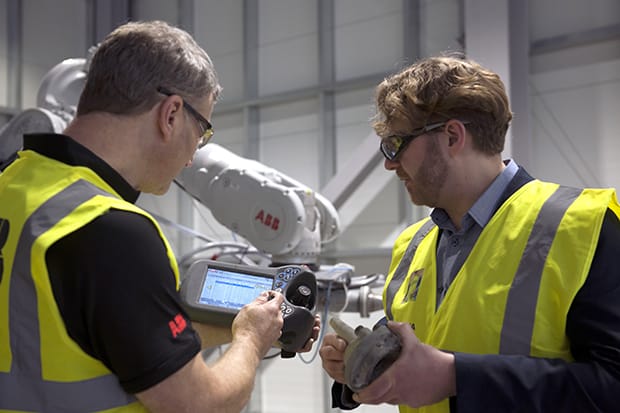The Contractor is at the forefront of research into robotic concrete printing. James Kenny saw the technology in action.
Skanska UK is aiming to create the world’s first commercial 3D concrete printing robot, which could be used on site to produce variety of elements including cladding panels. It hopes to have a commercial machine ready for operation within 18 months.
The contractor, which has a UK turnover of £1.4bn a year, has been working on a prototype of the robot for the last two years with partners Foster + Partners, Buchan Concrete, Lafarge Tarmac and robotics maker ABB. But it has accelerated development by becoming the first construction company to join the Manufacturing Technology Centre (MTC) in Coventry.
The MTC is a partnership between some of the UK’s major global manufacturing firms, including ABB, and three universities: Birmingham, Nottingham and Loughborough. It aims to provide a competitive environment to bridge the gap between university-based research and the development of innovative manufacturing solutions, in line with the government’s manufacturing strategy.
Skanska UK innovation manager David Lewis explained: “Up until December we were doing everything ourselves and had taken it as far as we could do, but by joining MTC we now have a proper lab and research facilities to conduct further tests and work on the project full-time.”
BIM+ sister title Construction Manager was recently given a tour of the facility and was able to witness a prototype robot in action – though photography was off-limits.

The MTC in Coventry (Daniel Graves)
Towering above the average person, the advanced six-axis robot is fitted with a computer-controlled printer nozzle, attached to a gantry and a robotic arm, which deposits a high-performance concrete.
The nozzle extrudes a bead of concrete about 10mm in diameter and, like a normal printer, makes passes back and forth in rapid succession, laying down successive layers of concrete until an entire 3D object is created.
Lewis said: “The robot would be particularly good for use in creating different cladding components, but there are options for other areas. We’ve had particular interest from Highways England – for example if they needed to make one complex concrete component for a road project.”
As part of the deal with MTC, Skanska has been given an injection of funding from Innovate UK for the next two years. The Innovate UK grant was worth £950,000. Similarly, £700,000 was awarded by Innovate UK over a year ago to develop robots for the construction of Battersea Power Station phase two.
In Battersea Skanska is working with ABB and Tekla to develop robots that can be deployed on site to carry out cutting, drilling and fixing. These are being used to build “utility cupboards” which house M&E components for individual apartments. That project is still ongoing and elsewhere Skanska is also working with ABB to develop a robot for setting out rebar cages in Sweden.
When questioned on how exactly the commercialisation of the new 3D concrete robot will work – and given that Skanska is not a subcontractor for concrete – the company said that this is another element that will be decided over the course of trials over the next two years, but that the main “emphasis of the robot is to support our supply chain”.

Skanska’s David Lewis uses the machine (Pam Campbell)
Sam Stacey, Skanska’s director of innovation and business development, said that the main processes over the next few months will be to make the whole robot and structure more physically robust so that once completed it can be used on any site. The biggest technical challenge going forward, however, is to make sure that the mix and consistency of the concrete is the same each time.
“We want to perfect the technology, but the end plan would be to make it smaller and mobile so it can be used on any site,” said Stacey.
According to Lewis, what is vital for Skanska with the 3D concrete robot is that it is the first to complete and perfect the technology, as there are a number of competitors in the UK and abroad who are developing their own or similar projects.
In the UK, BAM has teamed up with Universe Architecture to explore 3D stone and concrete building, while Netherlands-based CyBE Construction is also exploring the technology, as are a number of companies in China.
Lewis said: “Whoever gets there first wins, and there is quite a lot of competition. However, a lot of our competitors are trying to print whole 3D houses or large objects and we’re focusing on smaller cladding, curved panels and things like that.”
The robot would be particularly good for use in creating different cladding components, but there are options for other areas. We’ve had particular interest from Highways England – for example if they needed to make one complex concrete component for a road project.– David Lewis, Skanska UK















